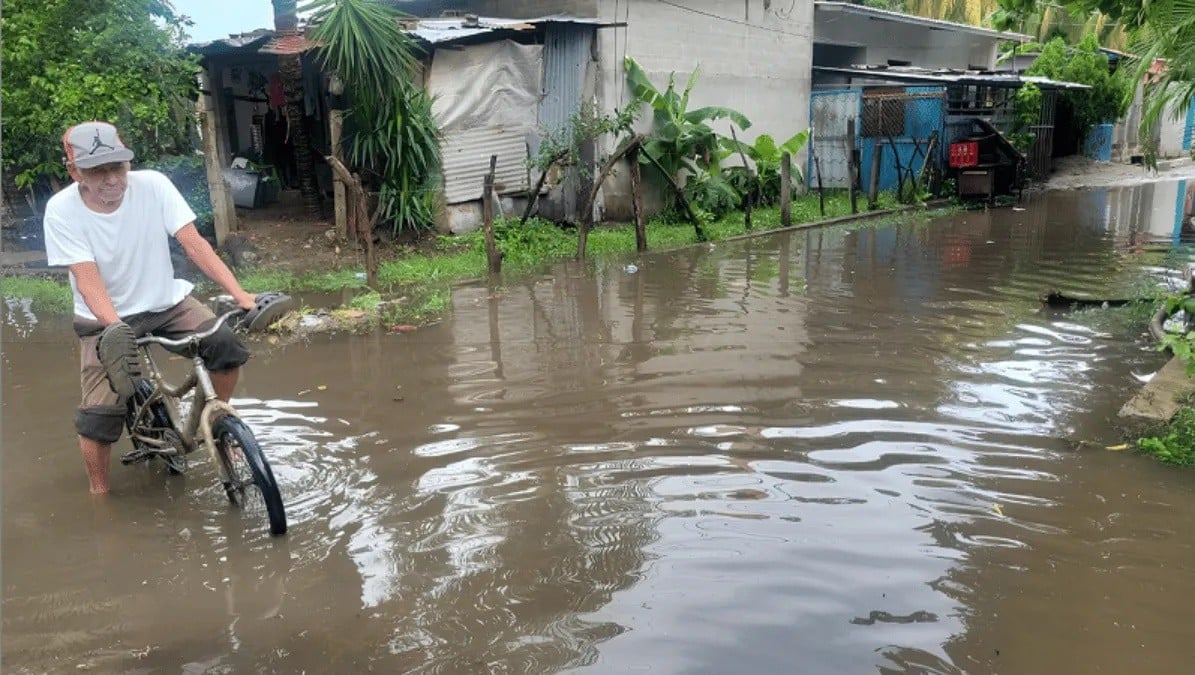The director general of Civil Protection, Luis Amaya, acknowledged this Monday that the surge in urban flooding in El Salvador directly correlates with tree felling and the proliferation of housing developments without proper territorial planning.
During a televised interview, he elaborated that these practices generate heightened runoff—the water that flows across the ground surface during rainfall—thereby amplifying the vulnerability of cities.
“The more trees felled, the more roads paved or housing complexes erected, the greater the runoff,” Amaya stated.
The official added that this predicament intensifies due to the inadequate capacity of the urban drainage system, which was designed decades ago under vastly different infrastructure and population density conditions. “If we tally it up, the capacity of that drainage system dates back to the last century. That inevitably breeds problems,” he affirmed.
The head of Civil Protection emphasized that addressing the flooding crisis demands a fundamental rethinking of the nation’s urban development. “No one can deny the need for housing solutions and infrastructure, but what we must champion is sustainable development that mitigates risks rather than instigating them,” he concluded.
According to Amaya, the rains battering the country in recent weeks have been intense and concentrated in short bursts, heightening the peril of waterlogging and landslides. This hallmark of convective storms, he explained, causes soils to saturate swiftly and urban drains to collapse with ease.
The director of Civil Protection noted that another pivotal factor is the absence of maintenance and improper waste disposal. “Whenever we respond to a flood, we find trash clogging the storm drains. It is not for lack of cleaning, but because there is a human factor that we must change,” he maintained.
As he explained, although municipal governments and the Ministerio de Obras Públicas (Ministry of Public Works) conduct cleaning operations, the solid waste that citizens discard onto the streets ultimately obstructs the sewers.
Amaya detailed that Protección Civil keeps the country’s 14 departmental and 44 municipal operations centers active to handle emergencies during the current rainy season. In recent weeks, he said, preventive evacuations have occurred in La Unión, landslides in Panchimalco, and fallen trees in Chalatenango, Cabañas, and San Miguel.
Despite the severity of the rains, the official highlighted that, to date, no fatalities have been reported from vehicle sweeps or inundations. “This is a year we hope to conclude without tragedies of that nature,” he assured.
He also recalled that between October 13 and 17, the “Semana de la reducción de riesgos” (Risk Reduction Week) will be held, with educational activities and a national evacuation drill on Thursday the 16th, as part of the Día Internacional para la Reducción de Desastres (International Day for Disaster Risk Reduction).
Protección Civil admite que inundaciones se deben a deforestación: “A mayor cantidad de árboles talados y complejos habitacionales construidos, mayor es la escorrentía”
El director general de Protección Civil, Luis Amaya, reconoció este lunes que el aumento de las inundaciones urbanas en El Salvador está directamente relacionado con la tala de árboles y la expansión de proyectos habitacionales sin una adecuada planificación territorial.
Durante una entrevista televisiva, explicó que estas prácticas están generando un incremento en la escorrentía —el agua que fluye sobre la superficie del suelo durante las lluvias—, lo que aumenta la vulnerabilidad de las ciudades.
“A mayor cantidad de árboles talados, a mayor cantidad de carreteras pavimentadas o complejos habitacionales construidos, mayor es la escorrentía”, señaló Amaya.
El funcionario agregó que esta situación se agrava debido a la falta de capacidad del sistema de drenaje urbano, diseñado hace varias décadas, cuando las condiciones de infraestructura y densidad poblacional eran muy distintas a las actuales. “Si hacemos cuentas, la capacidad con la que se construyó ese sistema de drenaje es del siglo pasado. Eso sí o sí genera problemas”, afirmó.
El titular de Protección Civil insistió en que la solución al problema de las inundaciones pasa por replantear el desarrollo urbano del país. “No se puede negar que hay necesidad de soluciones habitacionales e infraestructura, pero a lo que sí deberíamos apostarle es a un desarrollo sostenible, que reduzca riesgos y no que los provoque”, concluyó.
De acuerdo con Amaya, las lluvias que afectan al país en las últimas semanas han sido intensas y concentradas en períodos cortos, lo que aumenta el riesgo de anegamientos y deslaves. Esta característica de las tormentas convectivas, explicó, provoca que los suelos se saturen rápidamente y que los drenajes urbanos colapsen con facilidad.
El director de Protección Civil dijo que otro factor determinante es la falta de mantenimiento y el desecho inadecuado de basura. “Siempre que llegamos a atender una inundación encontramos basura en los tragantes. No es porque no se haga limpieza, sino porque hay un factor humano que debemos cambiar”, sostuvo.
Según explicó, aunque las alcaldías y el Ministerio de Obras Públicas realizan labores de limpieza, los desechos sólidos que los ciudadanos lanzan a las calles terminan obstruyendo las alcantarillas.
Amaya detalló que Protección Civil mantiene activos los 14 centros de operaciones departamentales y 44 municipales del país para atender emergencias durante la actual temporada lluviosa. En las últimas semanas, dijo, se han registrado evacuaciones preventivas en La Unión, deslizamientos en Panchimalco y la caída de árboles en Chalatenango, Cabañas y San Miguel.
A pesar de la magnitud de las lluvias, el funcionario destacó que, hasta el momento, no se han reportado víctimas mortales por arrastres de vehículos o inundaciones. “Este es un año que esperamos cerrar sin tragedias de ese tipo”, aseguró.
Asimismo, recordó que entre el 13 y el 17 de octubre se desarrollará la “Semana de la reducción de riesgos”, con actividades educativas y un simulacro nacional de evacuación el jueves 16, en el marco del Día Internacional para la Reducción de Desastres.

